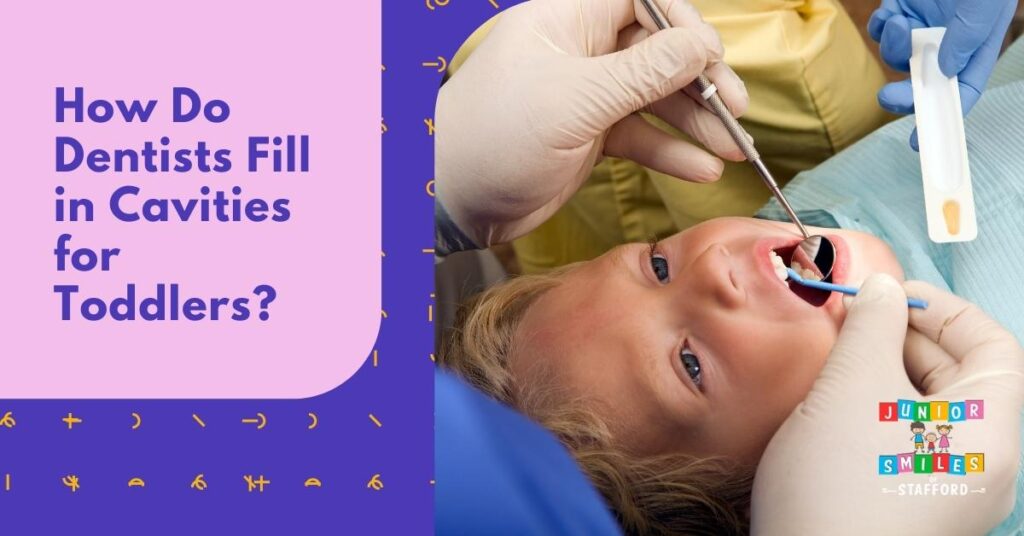How Do Dentists Fill Cavities in Toddlers?

The primary purpose of the baby teeth is to hold the space for the permanent adult teeth to erupt from the gums, even if the baby teeth will fall out at some point. This allows the permanent teeth to grow properly and with adequate space. That’s why it’s crucial to start teaching kids about good dental hygiene practices as soon as their baby teeth erupt, and not wait until they’re older.
Cavities can develop in children even when you take great care to prevent them. The primary goal in both adult and pediatric cavity prevention is the same: to keep teeth healthy. You may help your children’s teeth avoid more damage by treating cavities as soon as you see them if you know what to look for. Find out more about cavities and how dentists treat them in this blog. Read on.
Understanding Cavities in Toddlers
Cavities, also known as dental caries, are primarily caused by the presence of bacteria within the oral cavity. In the absence of adequate oral hygiene practices, harmful bacteria in the mouth have the ability to produce acids as a result of consuming unhealthy foods, including those that are high in sugar or processed. Acidic substances gradually erode tooth enamel, leading to the development of cavities over time.
Caries in the mouths of youngsters are fairly prevalent. Among youngsters aged 6 to 8, a considerable portion had suffered cavities in their primary teeth, as reported by the CDC. The Centers for Disease Control and Prevention (CDC) estimates that 52% of kids in this age bracket have experienced this dental health problem. Research shows that children from low-income homes are twice as likely to get untreated cavities than children from higher-income families.
How Do Toddlers Get Cavities?
Plaque can form when the naturally occurring germs in the mouth become trapped on teeth. A film that coats teeth, plaque is the result of bacterial action in the mouth together with food particles, acid, and saliva. The buildup of plaque and germs on teeth can cause cavities and decay if not addressed with regular dental cleanings. This is a universal oral process that happens to people of all ages.
Babies don’t have any teeth yet, so there’s no surface for plaque and bacteria to colonize. In contrast, once they begin to erupt, both adult and baby teeth are equally vulnerable to tooth decay. Children frequently get cavities because they don’t brush their teeth correctly, which allows plaque to accumulate. Regular brushing and flossing helps avoid this.
What Do Cavities Look Like in Toddlers?
An early sign of a cavity in a child’s tooth can be a white spot on the tooth’s surface. Discoloration between the front teeth or along the gumline will be easy to spot. When the white spot turns brown or black, it means a cavity is about to break out. Cavities on rear teeth might seem purple or black and sometimes have a subtle “shadow” surrounding them. And the biting surfaces of the rear teeth will get deeper grooves where the coloring will show. Even so, a spot on a rear tooth might be mistaken for a cavity. Consultation with a skilled dentist is thus necessary for optimal cavity identification.
How Long Do Cavities Take to Form?
While the exact time it takes for a cavity to develop varies from one case to the next, on average it takes years. However, children may start showing signs of tooth decay within a few months. This happens because cavities can develop more rapidly in primary teeth than in permanent teeth because the enamel layer is thinner in the former. Some medications, dry mouth, and health conditions increase the likelihood that a patient would have severe decay quickly.
The position of the cavity may also influence how quickly it develops. Because of the higher concentration of bacteria and plaque in some regions of the mouth, the development of cavities in such places is frequently sped up compared to other parts of the mouth.
How Dentists Fill Cavities in Toddlers
In order to prevent tooth extractions, pediatric dentists will exhaust every possible means of tooth preservation. When all other treatment options have been tried and failed, the decision to remove the baby tooth is made as a last resort. The following are some treatments they may consider:
Tooth Filling
Dental fillings are tiny enough that your child’s dentist should be able to fix a little cavity in a tooth. The dentist will start by drilling out the infected tooth. Afterwards, your dentist will fill the tooth’s hole using a resin that matches the tooth’s color.
Baby Tooth Crowns
Tooth decay can progress to the point where a crown is necessary, as determined by the dentist. When a tooth has to be strengthened or restored, a teeth-shaped cover called a crown is put over it. Most people only need to visit the dentist once for a dental crown, much like getting a filling for a baby tooth. After numbing the tooth’s surface, the dentist will remove decay and prepare the tooth for the crown. The next step is to mount it, and then cement it into place.
Pulpotomy
If the decay has reached a level where it is irritating the pulp or has penetrated the tooth itself, a pulpotomy may be necessary for your child’s teeth. The dentist will first extract the infected pulp chamber from the tooth, after which the decaying tissue will be removed.
In order to bring the tooth back to its original strength, the dentist will typically need to install a stainless steel crown over it. A pulpotomy, which is often done on a newborn molar, is very similar to a root canal but doesn’t include removing the tooth roots.
Alternatives to Filling Cavities in Baby Teeth
Dental sealants are an alternative to fillings. Sealants lessen the likelihood of cavities by preventing food and germs from being trapped in the teeth’s grooves and depressions. Their application is gentle, and they have a long lifespan (years). By minimizing the likelihood of a filling becoming necessary, they serve as a preventative strategy.
Getting a baby tooth treated with silver diamine fluoride is another option besides getting a cavity filled. Drilling is not necessary for the non-invasive silver diamine fluoride therapy. The presence of fluoride in this liquid has the ability to halt the degradation process and forestall its continuation. On top of that, the silver helps strengthen the tooth, which protects it from potential harm, and it also acts as an antimicrobial.
How to Prevent Cavities in Toddlers
The most effective method for dealing with cavities in children is to stop them from developing. Instruct them in the art of appropriate dental care, and watch their every move while they brush for the prescribed duration.
And remember, your youngster needs a professional cleaning and checkup at the dentist every six months. Dental x-rays and examinations by your child’s dentist can help find cavities. That manner, a cavity may be detected and treated before it worsens too much.
Toddler Cavity Filling FAQs
Are fillings painful for toddlers?
Although your child could feel some pressure during the injection of the anesthesia, it shouldn’t be very uncomfortable. For children who have anxiety or fear during dental procedures, some dentists give “laughing gas” to help them relax. Rest assured, it is completely non-toxic and will disappear as soon as the dental filling is complete.
Do small cavities need to be filled?
Filling minor cavities right away isn’t always necessary because they won’t necessarily get worse or even hurt. Fortunately, there are ways to prevent having to have a cavity-causing drill if you can detect tooth disease early on.
How long does it take to fill a cavity?
The filling procedure typically lasts for approximately one hour. When it comes to addressing multiple cavities in your child’s teeth, your dentist may opt for a treatment plan that involves multiple visits. This approach allows for a thorough and comprehensive approach to tackling the cavities, ensuring optimal oral health for your little one.
Do they put toddlers to sleep for fillings?
Sedation is a widely employed technique in pediatric dentistry, often utilized during various dental procedures, including fillings. By incorporating this technique, individuals can experience a heightened sense of relaxation, effectively alleviating any potential discomfort associated with the procedure. However, this particular method may not effectively get individuals to fall asleep.
Prevent Cavities Early with Junior Smiles of Stafford
Tooth decay isn’t just an issue for grown-ups; it may strike younger kids as well. Therefore, it is critical to see the warning indications of a cavity in your child and consult their dentist immediately. By incorporating excellent oral hygiene practices and reducing sugar consumption, you may shield your child’s teeth from potential cavities. Make an appointment with a highly recommended pediatric dentist to assess your child’s oral health. Dental visits for children may be fun and stress-free with the help of Junior Smiles of Stafford.

